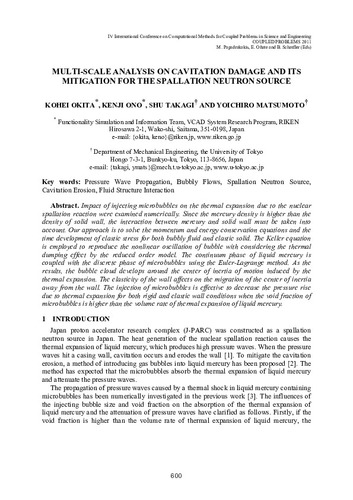Mostra el registre d'ítem simple
Multi-scale analysis on cavitation damage and its mitigation for the spallation neutron source
| dc.contributor.author | Okita, Kohei |
| dc.contributor.author | Ono, Kenji |
| dc.contributor.author | Takagi, Shu |
| dc.contributor.author | Matsumoto, Yoichiro |
| dc.date.accessioned | 2020-07-22T12:10:19Z |
| dc.date.available | 2020-07-22T12:10:19Z |
| dc.date.issued | 2011 |
| dc.identifier.citation | Okita, K. [et al.]. Multi-scale analysis on cavitation damage and its mitigation for the spallation neutron source. A: COUPLED IV. "COUPLED IV : proceedings of the IV International Conference on Computational Methods for Coupled Problems in Science and Engineering". CIMNE, 2011, p. 600-610. ISBN 978-84-89925-78-6. |
| dc.identifier.isbn | 978-84-89925-78-6 |
| dc.identifier.uri | http://hdl.handle.net/2117/327361 |
| dc.description.abstract | Impact of injecting microbubbles on the thermal expansion due to the nuclear spallation reaction were examined numerically. Since the mercury density is higher than the density of solid wall, the interaction between mercury and solid wall must be taken into account. Our approach is to solve the momentum and energy conservation equations and the time development of elastic stress for both bubbly fluid and elastic solid. The Keller equation is employed to reproduce the nonlinear oscillation of bubble with considering the thermal dumping effect by the reduced order model. The continuum phase of liquid mercury is coupled with the discrete phase of microbubbles using the Euler-Lagrange method. As the results, the bubble cloud develops around the center of inertia of motion induced by the thermal expansion. The elasticity of the wall affects on the migration of the center of inertia away from the wall. The injection of microbubbles is effective to decrease the pressure rise due to thermal expansion for both rigid and elastic wall conditions when the void fraction of microbubbles is higher than the volume rate of thermal expansion of liquid mercury. |
| dc.format.extent | 11 p. |
| dc.language.iso | eng |
| dc.publisher | CIMNE |
| dc.subject | Àrees temàtiques de la UPC::Matemàtiques i estadística::Anàlisi numèrica::Mètodes en elements finits |
| dc.subject.lcsh | Finite element method |
| dc.subject.lcsh | Coupled problems (Complex systems) -- Numerical solutions |
| dc.subject.other | Pressure Wave Propagation, Bubbly Flows, Spallation Neutron Source, Cavitation Erosion, Fluid Structure Interaction |
| dc.title | Multi-scale analysis on cavitation damage and its mitigation for the spallation neutron source |
| dc.type | Conference report |
| dc.subject.lemac | Elements finits, Mètode dels |
| dc.rights.access | Open Access |
| local.citation.contributor | COUPLED IV |
| local.citation.publicationName | COUPLED IV : proceedings of the IV International Conference on Computational Methods for Coupled Problems in Science and Engineering |
| local.citation.startingPage | 600 |
| local.citation.endingPage | 610 |


